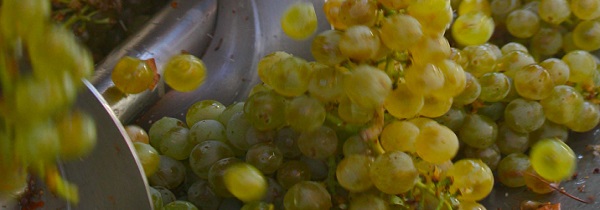White Wine Vinification
Credits: Bourgogne-wines.com

| HarvestingWhite grapes are harvested and sorted. |
Destemming / CrushingHarvested grapes are crushed to release the must. | |
Pressing / VattingPressing separates the juice from the skins, seeds, and stems. | |
FermentationYeasts transform the white grape juice into wine (sugar into alcohol). | |
MaturationMaturation refers to the time after fermentation. | |

| AgingAging refers to the changes in wine after bottling. |
Harvesting

The best quality wines are produced from hand-picked grapes
The first step to produce a white wine, is to harvest White Grapes.
The most common white grapes are:
- Chardonnay
- Sauvignon Blanc
- Riesling
- Pinot Grigio
- Pinot Blanc
Grapes are harvested when they have reached the optimal level of ripeness. This is crucial because it affects the sugar, acidity, and flavor profile of the wine.
Normally, harvest takes place early in the morning before sunrise, when the grapes are still cool from the night air, and then quickly transported to the winery to be pressed in a matter of hours.
Sorting
After harvesting, grape clusters are sorted (French:Triage) for quality.
Unripe, diseased, and damaged grapes, bugs and leaves are removed.

Sorting grapes before crushing
Destemming
After sorting, the grapes are destemmed to seperate the stems (stalks) from the grapes.
Modern machines do this so gently that only uncrushed berries come out at the other end.
Crushing
After destemming, the grapes are crushed to crack the skins and release some juice.
Modern machines are calibrated not to crush the seeds that are full of oil and bitter tannins.

Some machines crush and de-stem simultaneously.
Pressing / Vatting

Pressing is the process of separating the liquid (juice) from the solids (skins and seeds).
In the case of white wine, the grapes are usually pressed immediately after crushing, to separate the grape juice from the tannin rich skins and seeds.
This is the major difference between white and red wines. Most of the color in wine comes from the skins, and white wine is made from grape juice without contact with the skins.
Vatting is the vinification term for placing the grape juice into a vinification tank in which alcoholic fermentation can take place.
Alcoholic Fermentation
Alcoholic Fermentation transforms grape juice into wine (sugar into alcohol).
Yeast transforms the sugar in the juice, into alcohol, CO2, and heat:
=
Red wines are fermented at higher temperatures (20-32°C, 68-90°F) to extract more color and tannins. In addition fermentation in oak barrels can add wanted secondary flavors.
White wines are most often fermented in stainless steel tanks. This does not add ekstra aromatic compounds to the wine.
Rosé and white wines are fermented at lower temperatures (12-22°C, 54-72°F) to maximize the fresh fruit aromas.
Racking
After fermentation, the young wine contains particles and yeast sediments. To clarify the wine, it is typically transferred to another vessel, for example from tank to barrel, leaving the sediment behind.
Wine racking is the process of moving the wine from one vessel to another, leaving the leftover sediment behind in the previous tank or barrel.
Clarification
Some winemakers may also use fining agents or filtration to achieve greater clarity.
Malolactic
Malolactic Conversion or Fermentation (MALO or MLF) is optional and converts Malic Acid into Lactic acid. The wine becomes more stable, flavor changes and the acidity is slightly reduced.
MLF transforms the aromatic compounds from citrusy, green, refreshing and crispy to buttery, lactic, nutty, yeasty, oaky, sweaty and earthy.
Blending
Winemakers may blend different batches of wine to achieve the desired characteristics. Blending can involve combining wines made from different grape varieties or batches with varying aging conditions.
Blending is essential in large wineries where the winemaker has access to various barrels of various characteristics that may complement each other.
Maturation

Maturation refers to the period after Fermentation before Bottling
Maturation refers to a period of time after Fermentation and before Bottling. During this time the wine goes through changes: blending, MLF, clarification, stabilization etc.
The wine color progressively changes to darker tones: from green to yellow straw to gold and the grape-derived aromas fade.
White wines may undergo various aging processes, depending on the winemaker's preference and the style of wine they are aiming for. Some white wines are aged in stainless steel tanks to maintain a fresh and crisp character, while others may be aged in oak barrels for added complexity and flavor.
Stabilization
Before bottling, the wine may undergo processes to stabilize it, such as cold stabilization to precipitate tartrates that can cause sediment in the bottle, or the addition of sulfur dioxide to prevent oxidation.
Filtration
The wine is often filtered to remove any remaining particles or yeast cells before bottling.
Bottling
The final step is to fill the wine into bottles, which are then sealed with corks or alternative closures. Some white wines may be bottled and released shortly after production, while others benefit from additional bottle aging.
Aging

Aging refers to the changes in wine after bottling
White Wine Vinification
White wines grapes are pressed to remove the skin and seeds before fermentation.
The grapes are pressed BEFORE fermentation.
 |
 |
 |
 |
|
| Crush | Press | Ferment | Mature |
Age |
Red Wine Vinification
Red wines are fermented with the skins and seeds included.
The grapes are pressed AFTER fermentation.
 |
 |
 |
 |
|
| Crush | Ferment | Press | Mature | Age |